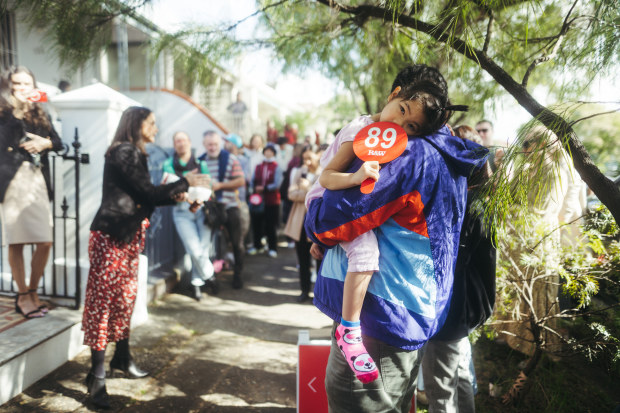
Investors, holiday homeowners and commercial property holders will pay almost $5 billion of Victoria’s planned $8.6 billion COVID-19 debt levy over the next four years as a result of lower tax-free thresholds, higher rates and extra fixed payments on their land tax assessments.
In Tuesday’s budget, Treasurer Tim Pallas said the state would raise an additional $1.15 billion next year alone by cutting the tax-free threshold for land tax from $300,000 to $50,000, and levying temporary fixed charges of $500 for properties up to $100,000 in value and $975 on those up to $300,000.

Owners of multiple properties will do the heavy lifting for Victoria’s budget repair. Dion Georgopoulos
For land holdings worth more than $300,000 (and properties owned by trusts worth more than $250,000), yearly land tax payments will rise by $975 plus 0.1 percentage point of the value of the land over $300,000.
The separate abolition of stamp duty on commercial and industrial properties will partly offset the higher land tax imposts for some owners.
However, the extra $4.74 billion the government is expecting to reap in financial year 2024 and the following three years will hit investors and owners of multiple properties who already face higher stamp duty payments, reflecting recent gains in land values.
Justifying the higher taxes, which will be in place for the next 10 years, Mr Pallas cited an 84 per cent increase in land values over the past decade and the 25 per cent surge in rents in Melbourne and regional Victoria over the past 12 months.
“These higher rents are due to effectively the laws of supply and demand at play and they’re delivering a windfall to landlords,” he told journalists before his speech to parliament on Tuesday.
“We think that it’s fair that Victorians with multiple properties make a modest contribution to repaying COVID-19 debt.”
The lower threshold would lift the number of landowners paying land tax by about 380,000 to 860,000, he said.
Exemptions continue
Under the new system, the land tax payment for the owner of an applicable property with an unimproved land value of $1 million will rise from $2975 currently to $4650; on a $2 million property it would rise from $12,475 to $15,150; on a $5 million property the payment would increase from $78,975 to $84,650 and for a $10 million property up from $206,475 to $217,150.
Properties already exempt from land tax, including principal places of residence, farmland, retirement homes and land owned by charities or religious institutions, will stay that way.
The Real Estate Institute of Victoria panned the move.
“This announcement will ultimately drive mum and dad investors out of the market as the cost of maintaining a rental property outweighs futureproofing family finances,” REIV CEO Quentin Kilian said.
“The biggest impact will be felt by people with smaller holdings as the tax-free threshold drops from $300,000 to just $50,000, disproportionately impacting everyday Victorians investing to secure their future.”
Developer body UDIA Victoria said the higher land tax would add to the cost of building housing and push prices higher.
“An increase in land tax will disincentivise the development of new homes,” president Tom Travaskis said. “We also don’t want to see land tax increases being passed through to renters in an already challenging market.”
Mr Pallas, who again ruled out extending stamp duty changes to residential property, said the decision to transition away from lump-sum stamp duty payments on commercial property transactions from the middle of next year would free up capital and allow businesses to expand.
“This will be landmark reform, a reform that will liberate businesses from their locations and give them the opportunity to move where the work is and where their markets are best located without having to deal with the substantial costs of stamp duty,” he said.
Current owners will not be affected providing they own the property.
Any purchaser of commercial or industrial land after July 1, 2024, will have the choose of paying stamp duty upfront or in a lump sum or to transition to annual payments in fixed instalments over 10 years equal to the stamp duty plus interest, with the aid of a government-facilitated loan.
If they opt for fixed payments, no further stamp duty will be payable if they sell within that ten-year period, but an owner who sells will be obliged to meet their obligations on the outstanding payments.
After the initial 10-year period, annual property tax will apply at a flat 1 per cent rate of a property’s unimproved land value.
State revenue from stamp duty – or land transfer duty, as the budget papers call it – will likely sink 20.7 per cent this year to $8.2 billion as a result of dropping settlement volumes after the last year’s post-COVID boom in transactions.
Stamp duty receipts will fall a further 10.4 per cent in FY24 to $7.4 billion before recovering to $8.1 billion in FY24 and rising at an average 8.4 per cent annual rate over the forward estimates, the government forecasts show.
Across the state, housing prices are likely to record a 3.5 per cent decline this calendar year.
“In part, this reflects price falls in the early months of 2023, which have now moderated amid low supply and limited distressed selling,” the budget papers say.
“Elevated migration and robust labour market conditions are expected to provide some support for residential property prices, but tight credit conditions are expected to remain a key factor in the short term.”
Prices would rise 6 per cent in calendar year 2024, the papers forecast.
“Transaction volumes are forecast to start recovering toward the end of 2023 and grow steadily by 15.3 per cent over 2024 to eventually stabilise at around mid-2010s levels,” the budget papers say.
Read more about the 2023 Victorian state budget
Bagikan Berita Ini














0 Response to "Victoria budget 2023: Property investors, holiday homes, commercial property to pay $5b COVID-19 bill - The Australian Financial Review"
Post a Comment